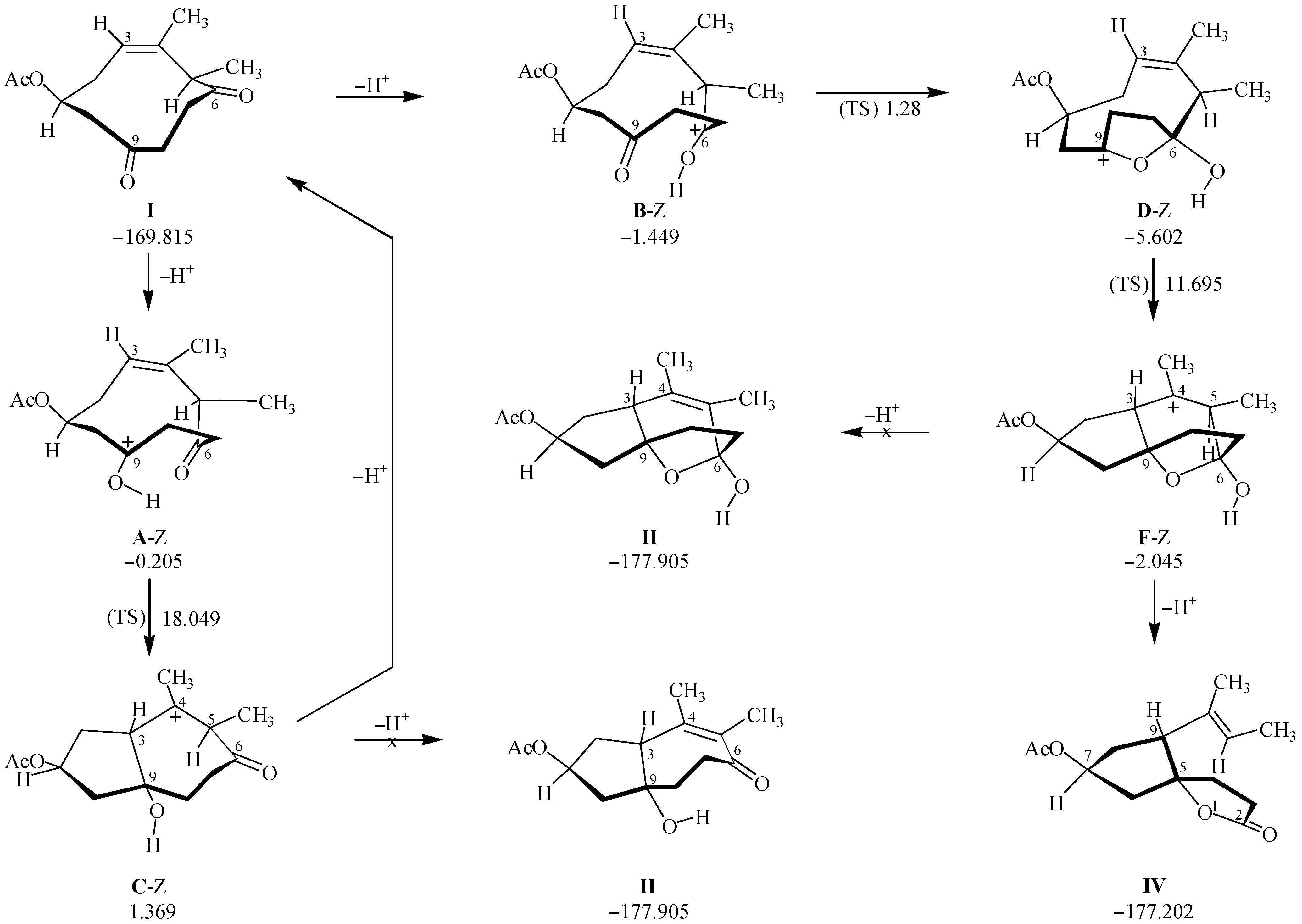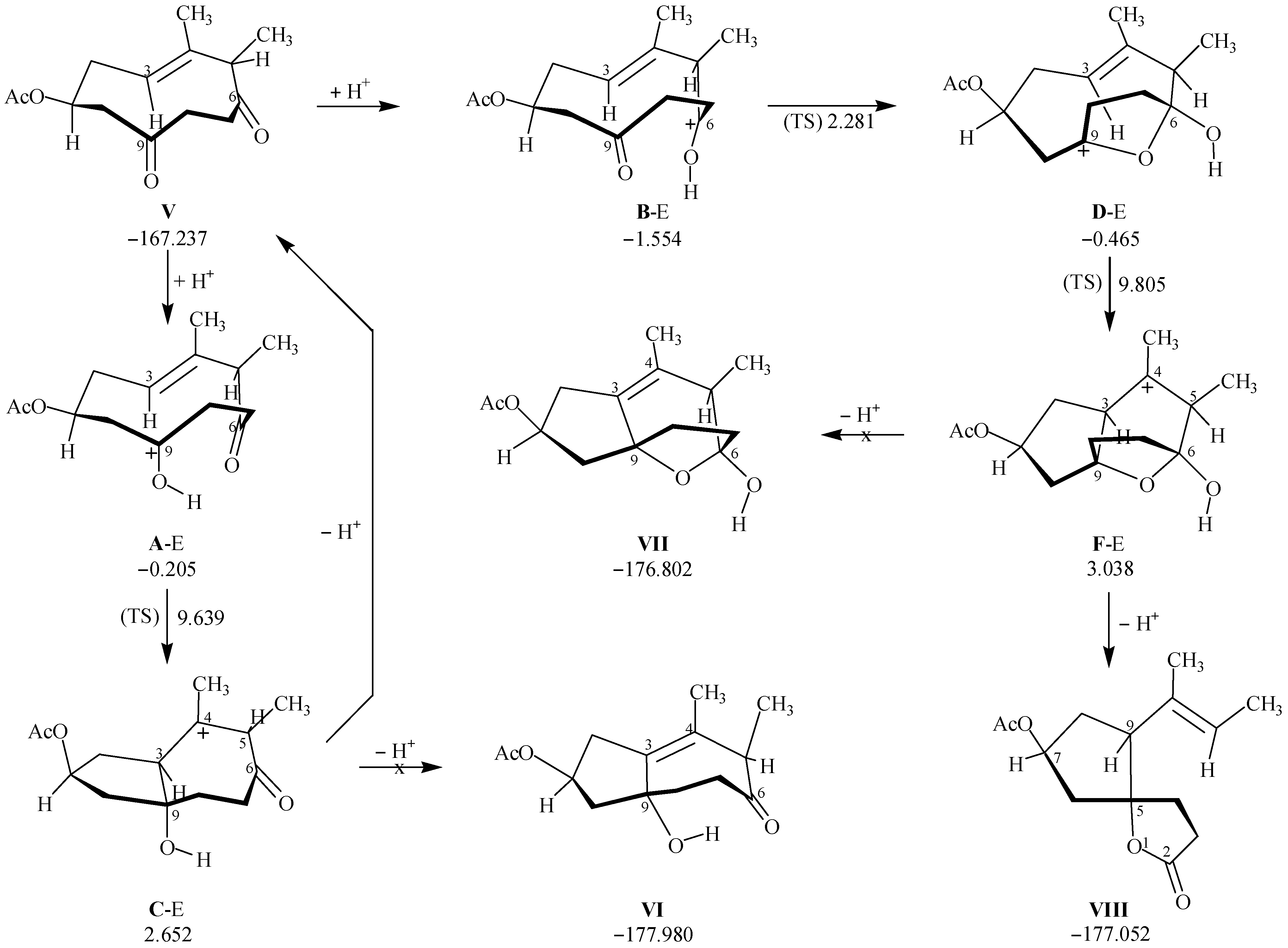Stereoselective Transformation of Cyclodecene-1,4-dione Systems, Derived from Steroids, to the Corresponding spiro-γ-lactones. A Semiempirical MO Study
Abstract
:Introduction
Method of calculation
Results and discussion
(Z)-isomer, I
(E)-isomer, V
References and Notes
- Lorenc, Lj.; Bondarenko-Gheorghiu, L.; Krstich, N.; Fuhrer, H.; Kalvoda, J.; Mihailovich, M. Lj. 72. Reactivity of 5,10:8,14-disecosteroids: An Unusual Rearrangement of Cyclodecene-1,4-dione Systems to Five-Membered-Ring Spiro-γ-lactones. Helv. Chem. Acta 1995, 78, 891–898. [Google Scholar] [CrossRef]
- Lorenc, Lj.; Bondarenko-Gheorghiu, L.; Pavlovich, V.; Krstich, N.; Mihailovich, M. Lj. Stereoselective transformation of cyclodecene-1,4-dione sytems, derived from steroids, to the corresponding spiro-γ-lactones. J. Serb. Chem. Soc. 1998, 63, 833–840. [Google Scholar]
- Mihailovich, M.Lj.; Lorenc, Lj.; Bondarenko, L.; Tinant, B.; Declercq, J.-P.; Van Meerssche, M. The Formation of 8,14-seco-steroid systems, 3β,5,17β-trihydroxy-8,14-seco-5α-androstan-8-one and its 3,17-diacetate ester. Tetrahedron 1986, 42, 189–192. [Google Scholar] [CrossRef]
- Lorenc, Lj.; Bondarenko, L.; Pavlovich, V.; Fuhrer, H.; Rihs, G.; Kalvoda, J.; Mihailovich, M.Lj. 5,10:8,9-Dsecosteroids (=Steroklastanes): A New Type of Modified Steroids. Helv. Chem. Acta 1989, 72, 608–623. [Google Scholar] [CrossRef]
- Mihailovich, M. Lj.; Pavlovich, V. D.; Bonradenko-Gheorghiu, L. G.; Krstich, N. M.; Dabovich, M.; Lorenc, Lj. B. Synthesis of modified 5,10:8,14-bisfragmentation cholestane derivatives. J. Serb. Chem. Soc. 1996, 61, 941–946. [Google Scholar]
- Dewar, M.J.S.; Zoebisch, E.G.; Healy, E.F.; Stewart, J.J.P. A New General Purpose Quantum Mechanical Molecular Model. J. Am. Chem. Soc. 1985, 107, 3902–3909. [Google Scholar] [CrossRef]
- Stewart, J. J. P. Optimization of Parameters for Semiempirical Methods. J. Comput. Chemistry 1989, 2, 209-220 and 221-264. [Google Scholar] [CrossRef]
- Wyttenbach, T.; Vonhelden, G.; Bowers, M. T. Gas-Phase Conformation of Biological Molecules: Bradykinin. J. Am. Chem. Soc. 1996, 118, 8355–8364. [Google Scholar] [CrossRef]
- Bock, H.; Nick, S.; Seitz, W.; Nather, C.; Bats, J. W. Structures of Charge-Pertubed or Sterically Overcrowded Molecules, 80. Structural Changes of p-Benzochinon by Donor and Acceptor Substituents. Z. Naturforsch. B 1996, 51, 153–171. [Google Scholar]
- Peslherbe, G. H.; Wang, H. B.; Hase, W.L. Trajectory Studies of SN2 Nucleophilic Substitution. V. Semiempirical Direct Dynamics of Cl---CH3Br Unimolecular Decomposition. J. Am. Chem. Soc. 1996, 118, 2257–2266. [Google Scholar] [CrossRef]
- Hu, W. P.; Truhlar, D. G. Factors Affecting Competitive Ion-Molecule Reactions: ClO- + C2H5Cl and C2D5Cl via E2 and SN2 Channels. J. Am. Chem. Soc. 1996, 118, 860–869. [Google Scholar] [CrossRef]
- Tabakovich, I.; Gunich, E.; Juranich, I. Anodic Fragmentation of Catharanthine and Coupling with Vindoline. Formation of Anhydrovinblastine. J. Org. Chem. 1997, 62, 947–953. [Google Scholar] [CrossRef]
- MOPAC output files containing the results of vibrational analysis could be found at Internet address: http://www.chem.bg.ac.yu/~ijuranic/diketon.htg/ as files named cisam1.vib and cispm3.vib. These files are suitable for the visualization with Re-View program.
- MOPAC output files containing the results of vibrational analysis could be found at Internet address: http://www.chem.bg.ac.yu/~ijuranic/diketon.htg/ as files named transam1.vib and transpm3.vib. These files are suitable for the visualization with Re-View program.
- The C-deprotonated compounds of type II and III in the (Z)-series, and of type VI and VII in the (E)-series, if formed at all, could be present as components of the respective complex mixtures (see Table 1), however, in very low yields.
- Marcus, R. A. Theoretical Relations among Rate Constants, Barriers, and Broensted Slopes of Chemical Reactions. J. Phys. Chem. 891–899. [CrossRef]
- Cohen, A. O.; Marcus, R. A. On the Slope of Free-Energy Plots in Chemical Kinetics. J. Phys Chem. 1968, 72, 4249–4256. [Google Scholar] [CrossRef]
- Murdoch, J.R. Rate-Equilibrium Relationships in Proton-Transfer Reactions. J. Am. Chem. Soc. 1972, 94, 4410–4418. [Google Scholar] [CrossRef]
- Albery, W. The application of Marcus relation to reactions in solutions. A. Rev. Phys. Chem. 1980, 31, 227–263. [Google Scholar] [CrossRef]
- Sample Availability: Available from the authors.



| Substrate | ConditionsΔ/AcOH, r.t. | Producta yield (%)b | Conditions HI/CCl4, r.t. | Producta yield (%)b | Conditions HClO4/acetone, r.t. | Producta yield (%)b |
| Time (h) | Time (h) | Time (h) | ||||
| 2a | 4 | 4a (66.0) | 2 | 4a (77.4) | 0.5 | 4a (48.2) |
| 3a | 4 | 5a (59.3) | 4 | 5a (53.4) | 1 | 5a (62.5) |
| 2b | 4.5 | 4b (47.6) | 1 | 4b (52.4) | ||
| 3b | 14 | 5b (9.5) | 2.5 | 5b (54.3) |
© 1999 by the authors. Reproduction of this article, by any means, is permitted for noncommercial purposes.
Share and Cite
Lorenc, L.; Pavlovich, V.; Juranich, I.; Mihailovich, M.L.; Bondarenko- Gheorghiu, L.; Krstich, N.; Dabovich, M. Stereoselective Transformation of Cyclodecene-1,4-dione Systems, Derived from Steroids, to the Corresponding spiro-γ-lactones. A Semiempirical MO Study. Molecules 1999, 4, 272-278. https://doi.org/10.3390/41000272
Lorenc L, Pavlovich V, Juranich I, Mihailovich ML, Bondarenko- Gheorghiu L, Krstich N, Dabovich M. Stereoselective Transformation of Cyclodecene-1,4-dione Systems, Derived from Steroids, to the Corresponding spiro-γ-lactones. A Semiempirical MO Study. Molecules. 1999; 4(10):272-278. https://doi.org/10.3390/41000272
Chicago/Turabian StyleLorenc, Ljubinka, Vladimir Pavlovich, Ivan Juranich, Mihailo Lj. Mihailovich, Lidija Bondarenko- Gheorghiu, Natalija Krstich, and Milan Dabovich. 1999. "Stereoselective Transformation of Cyclodecene-1,4-dione Systems, Derived from Steroids, to the Corresponding spiro-γ-lactones. A Semiempirical MO Study" Molecules 4, no. 10: 272-278. https://doi.org/10.3390/41000272




